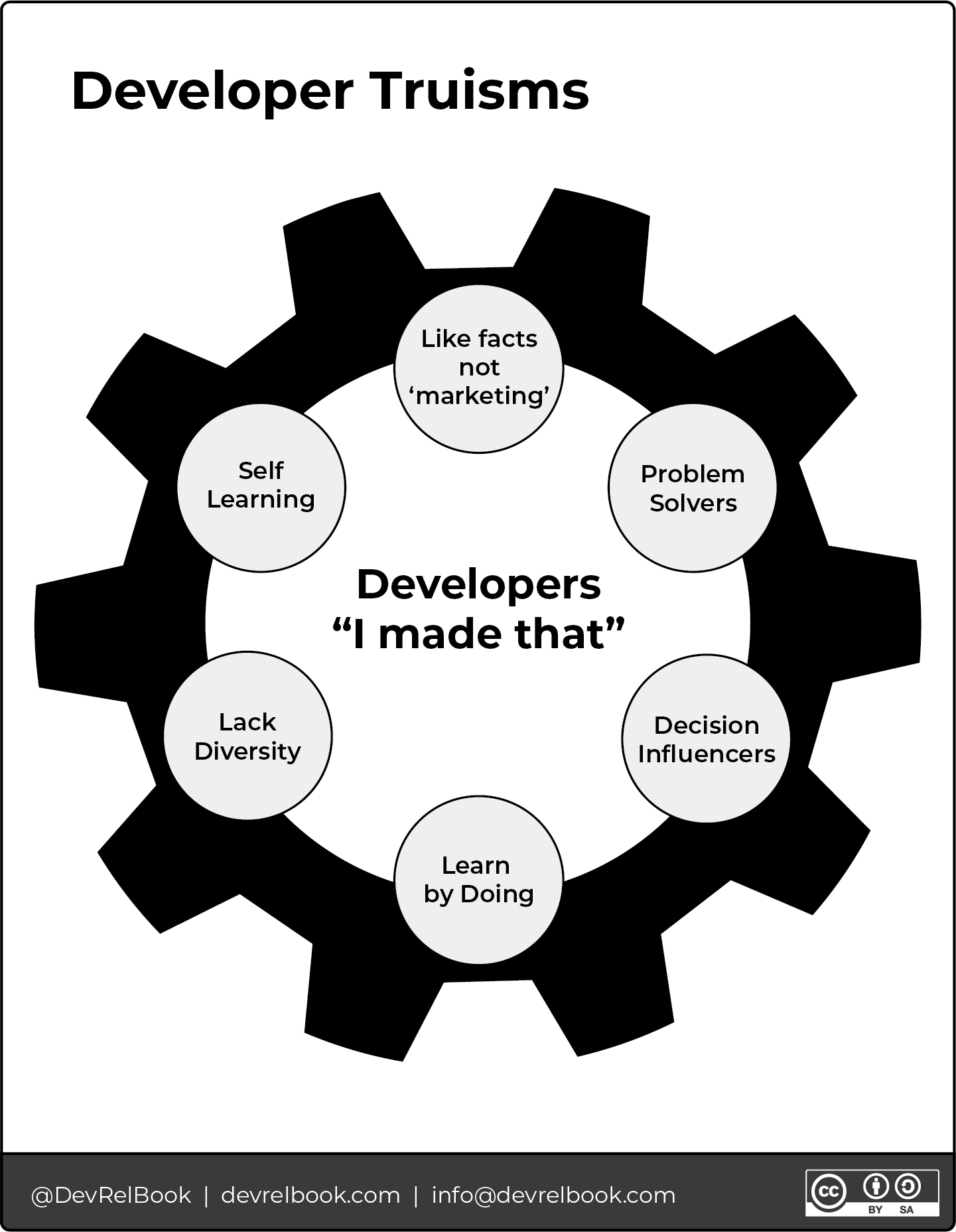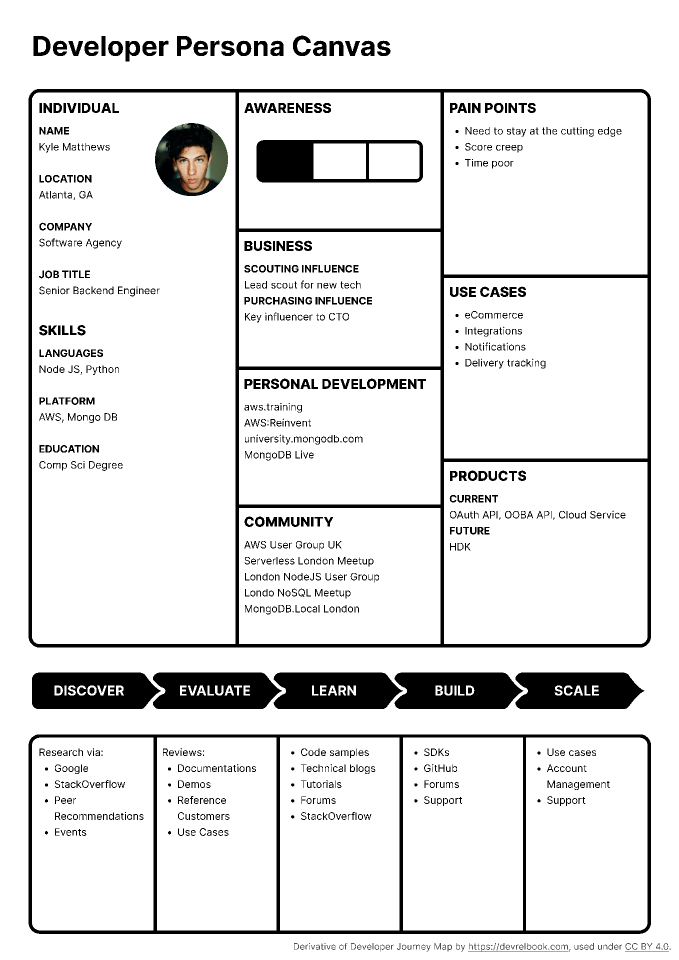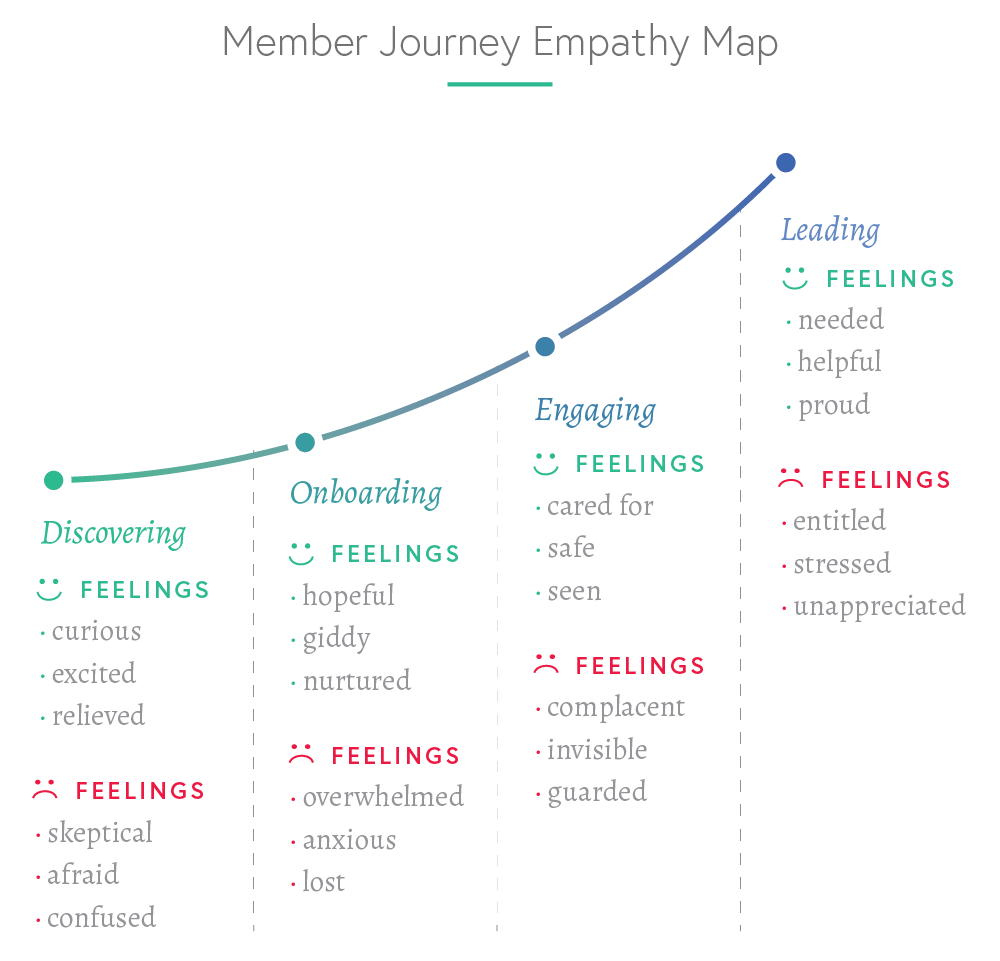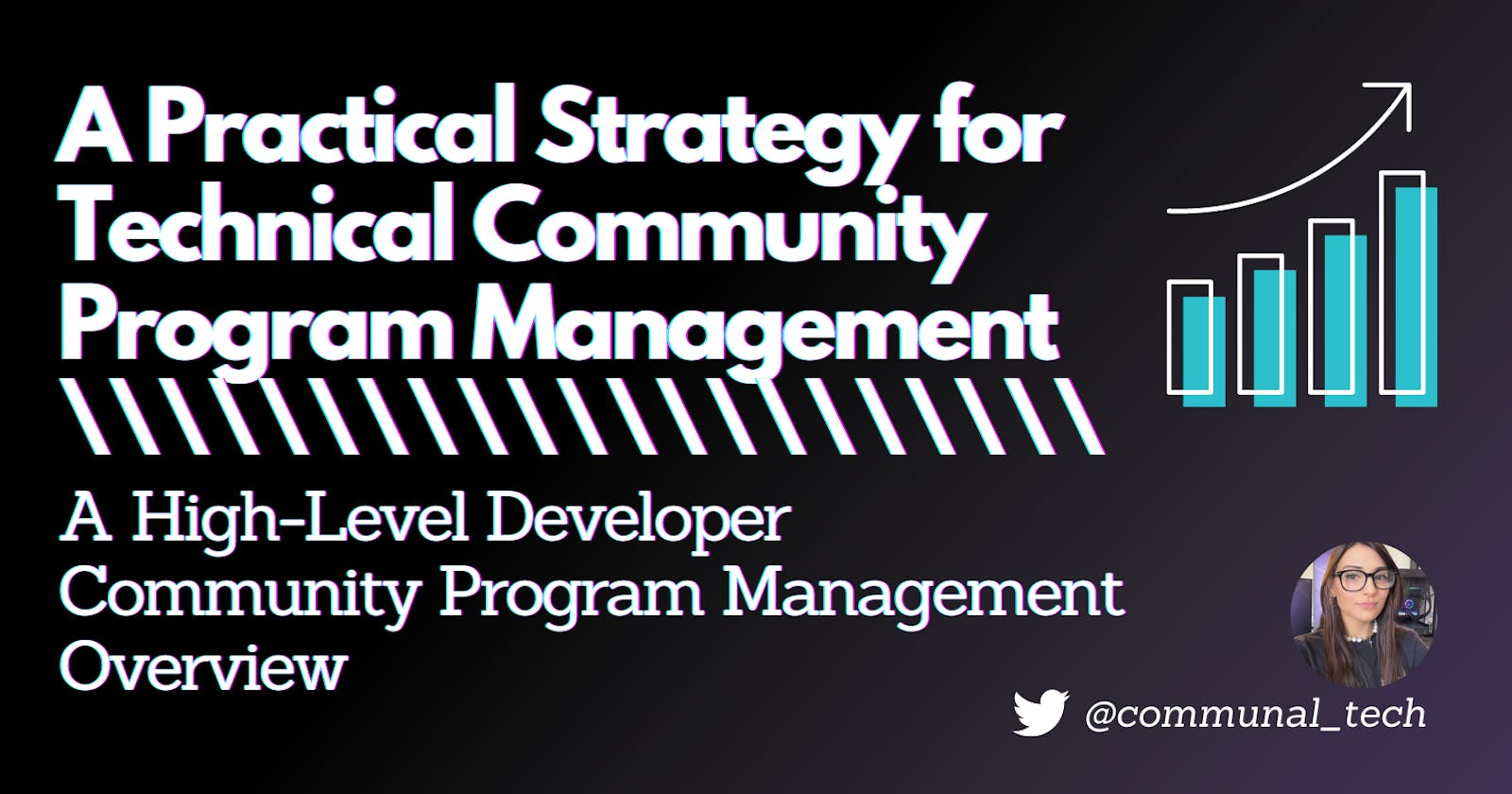A Practical Strategy for Technical Community Program Management
A High-Level Developer Community Program Management Overview
The new & improved version of this blog post has been posted to my LinkedIn:
Please consider viewing the updated version instead: https://www.linkedin.com/pulse/practical-strategy-technical-community-program-kylee-fields
This blog post is for anyone starting a new community program in the tech industry. In this article, I discuss an outline for a high-level, flexible community strategy designed to provide a starting point for developer community programs.
Definitions of Adjacent Roles
If you’re a community manager in tech, you’ve likely worked alongside other adjacent roles such as developer relations, developer advocacy, developer marketing, etc. to get your job done.
Before diving into technical community management, it's important to understand the scope of tech community work and how it differentiates from other developer-adjacent roles.
- Developer Relations:
While there is no single consensus on the definition of developer relations; it can be considered as “public relations” but tailored specifically for the tech industry.

These are some of the well-documented truisms of developers, which create the basis for developer marketing. |
Developer relations encompasses many roles — developer education, developer marketing, developer experience, developer evangelism, developer program management, developer success, and much more. It is the intersection of numerous departments, including community, business, content creation, and engineering. Professionals in this field may be responsible for designing developer retention initiatives, collaborating with marketing teams to produce technical content, and communicating developer feedback to engineering personnel.
The primary goals of developer relations are to engage with developers and to increase developer success throughout their journey.
- Technical Content Management:
Technical content creation is specialized social media management and knowledge base management for the tech industry. While most of us are familiar with social media management, knowledge base management focuses on technical material. This includes technical documents, blogs, presentations, libraries, and much more.
A technical content creator may write docs and tutorials, produce technical social media content to attract developers, and use a data-driven approach to technical content creation. The primary objective of technical content creation is to utilize technical documentation and materials as a strategic instrument for marketing purposes.
Four Aspects of Technical Community Management:
The terminology used by developer relations and community management professionals is not strictly defined. While there are no manuals providing universal definitions for all commonly used words, I like to divide my technical community program management strategy among 4 main themes:
Program Management
Managing the technical community program, usually working from the highest-level overview of the community. This looks like designing community commitment campaigns, mapping user experience, analyzing for strong & weak touchpoints, and social analytics.
Advocacy
Advocacy on behalf of the product and client, includes education, troubleshooting with users, onboarding, managing the knowledge bases, and more.
Communications
Representing the team to users and the users to the team (one of my favorite parts of the job.)
In the realm of technical community program management, effective communication is crucial for ensuring that the interests of all parties, ranging from users to stakeholders, are thoroughly addressed. This encompasses content development for various marketing channels, internal and external communication strategies, interdepartmental communication, and a plethora of additional aspects.
“I only debate my equals. All others, I teach.”
― John Henrik Clarke
Culture
Getting involved in the community itself and assessing it from the ground up and back down again. This can be from the lowest level of oversight, where you can gain the most insights about your community, to the highest level of oversight, where you can enact the most impactful change. For example, you can put on your beginner's mind and explore the community's culture from all its channels and stages the user's experience, and then from the top-down, you can enact impactful efforts, such as tech inclusion programs. This includes user journey mapping, moderation, representing the team, developer experience, and cultivating a safe, diverse community that aligns with your products values.
All of these four pillars come together to promote sustainable community growth.

My working interpretation of the 4 major themes of technical community management -- Program Management, Advocacy, Communications, and Culture |
Tech Community Program Management Strategies:
Note: I don't use a one-size-fits-all approach, my primary tasks and order of operations depend on the needs of each community. Here is a basic, starter guide to my technical community program management strategy.
1. Assess the Basics:
Get to know the current state of the community.
What type of technical community is this? (Some common types: developers only, developers + users, organizations, etc.)
How large is the community and what is the current commitment level distribution?
Why do community members join? Why do they stay?
What are your first impressions of the product across all current channels to the market?
Consider creating a "Community Insights dashboard" that showcases the community's starting health prior, complete with community metrics (which I will cover later in this post.)
2. Determine Program Objectives:
Create clear job goals and objectives for your program. Make sure they align with your client's goals, these goals do not need to be highly specific or measurable, we will get to that! This stage is all about listening to your client / community before picking apart their goals into manageable steps. Make sure you gather both what product owners, clients, community members, users, stakeholders, and all relevant parties want AND don't want then determine your scope and resources.
What do the product owners want & what do they want to avoid?
- What do the community members want & what do they want to avoid?
What value will your program bring to stakeholders & users?
What is your scope and what are your available resources?
Example Goals:
Create new channels to the market to increase crowd-sourcing.
Simplify service access to increase user satisfaction.
Build the infrastructure for sustainable community growth by designing commitment campaigns.
3. Analyze User Journey Maps:
This is an explorative task for discovering the community from the ground up. You adopt a beginner's mind and go through the process as you would a community member, and assess for strengths & weaknesses, onboarding gaps, and more. If you are brand new to a community, take advantage of it! This is the best time to analyze everything from the perspective of a beginner. Map the positive, negative, and neutral experiences of your user journey to prepare for presenting to stakeholders later on.

Questions to consider:
Where are users coming from?
Get to know the community, and develop user personas (pictured below).
Should we scale the community horizontally or vertically next?
What are the current channels to the market?
What is the onboarding process like?
How is the product being used and providing value from the user's perspective?
Note all positive and negative experiences and feelings during this process.

Developing a persona canvas for developers -- a reference profile to help better understand community members. |
4. Develop Technical Community Commitment Campaign Program:
This is where you dive deeper into your work, dig into your developer relations arsenal, and accomplish your goals. First, you design programs to meet your client's and community's goals. This can be one program or multiple, each containing 1 or more community campaigns to meet the program's goals. My favorite starting point here is community commitment curves (pictured below) which map out the user experience across different levels of commitment and the respective tasks they're participating in. Next, you will fine tune these tasks into measurable, highly prioritized phases.
From here, using the community commitment curve, it's time to:
determine touch points between stages and data points for measuring them.
identify the problem areas from your gap analysis and what solutions can be implemented on the community curve.
set up new touch points on the curve to provide incentives and rewards to users, in alignment with the program's goals.
Some more examples of community campaign goals:
build a scalable content creation strategy and social media pipeline.
rewarding users for their commitment to membership programs.
optimize and scale educational efforts and onboarding processes to increase developer success.
monitor the community for bad actors to reduce trust & safety violations and support user happiness
If you are feeling lost in exactly what kind of campaigns will work best, I recommend using a Lean Business Model to help break down your options into deconstructed concepts for more informed value analysis.

Lean Canvas Business Decision-Making Model (pictured above)

An example of a simple empathy map, highlighting the desired emotions of target users. By Carrie Melissa Jones
5. Create a SMART plan (Specific, Measurable, Achievable, Relevant, Time-Bound):
After gaining a solid grasp of your community program's high-level overview, it's time to gather all the insight from the previous steps to hone in on the specifics of your community program. This is where you assess your available resources, potential room for scalability, and activate prioritization methods to help organize tasks into a strategic plan. First, begin by setting program metrics, timelines, and deliverables!
- Make your goals SMART (Specific, Measurable, Achievable, Relevant, and Time-Bound). An example of a SMART-goal statement might look like this:
Our goal is to [quantifiable >objective] by [timeframe or deadline]. [Key players or teams] will accomplish this goal by [what >steps you’ll take to achieve the goal]. Accomplishing this goal will [result or benefit].
Create plans for consistent progress measurement. Community metrics can be difficult to measure, especially if you're working in a fast-paced startup environment where there is no time for deep, statistical assessment. However, throughout my experience I have learned that there are always community metrics to measure, you just may not have time to dive deep into it. As a starting point, I would use OKRs & KPIs and start with basic community metrics, such as # website visitors, # of engagements on content, and length of engagement. If you're lost for community metrics, simply Google "community metrics" for ideas! Also, you can check the resources below for more inspiration.
Create systems for prioritizing tasks when there are too many things to do, such as when emergencies are flagged and you need to reprioritize your plan without getting off track. For example, after you've created a series of content, you can measure which content type is the most effective to prioritize moving forward. To do this, you can start by creating a rating system between 3-5 factors, most of them should be quantifiable but not necessarily all of them, then rate each piece of content and how it performed, total up the ratings and prioritize content wit the highest score.
Determine milestones within your timelines where specific goals are reached, scope of your program, key figures and their responsibilities, necessary technology required, and plans for reporting and review.
Make sure to document your processes and manage your programs knowledge base!
Now you are ready to start managing your own technical community. Be sure to check out the resources below for additional guidance. What else would you add to this technical community management plan? Feel free to comment or ask questions, I always appreciate feedback. :)
Additional Resources:
- Community metrics Airtable by Tessa Kriesel, Head of Developer Relations at Snapchat.
- List of DevRel Resources by DevRel.com
- Community Resources Dashboard: Threado Community Resources - Case Studies, Jobs, Newsletters, and more!
- Book: The Art of Community: Building the New Age of Participation
- Book: People Powered: How Communities Can Supercharge Your Business, Brand, and Teams
- The Ultimate Guide to Developer Community Management for Beginners
- AWS Community Resources Center
- Leveraging the Power of Community by Mary Thengal at PostmanCon
- The Many Faces of A Community Manager by Red Hat
- Free Community Management Template Kits by HubSpot
- Community Manager Toolkit by Microsoft
- Resources for Community Managers by Community Roundtable

